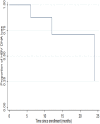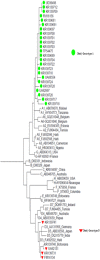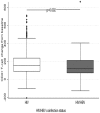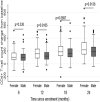Slow CD4+ T-Cell Recovery in Human Immunodeficiency Virus/Hepatitis B Virus-Coinfected Patients Initiating Truvada-Based Combination Antiretroviral Therapy in Botswana
- PMID: 27800524
- PMCID: PMC5084712
- DOI: 10.1093/ofid/ofw140
Slow CD4+ T-Cell Recovery in Human Immunodeficiency Virus/Hepatitis B Virus-Coinfected Patients Initiating Truvada-Based Combination Antiretroviral Therapy in Botswana
Abstract
Background. Hepatitis B virus (HBV) and human immunodeficiency virus (HIV) coinfection has emerged as an important cause of morbidity and mortality. We determined the response to Truvada-based first-line combination antiretroviral therapy (cART) in HIV/HBV-coinfected verus HIV-monoinfected patients in Botswana. Methods. Hepatitis B virus surface antigen (HBsAg), HBV e antigen (HBeAg), and HBV deoxyribonucleic acid (DNA) load were determined from baseline and follow-up visits in a longitudinal cART cohort of Truvada-based regimen. We assessed predictors of HBV serostatus and viral suppression (undetectable HBV DNA) using logistic regression techniques. Results. Of 300 participants, 28 were HBsAg positive, giving an HIV/HBV prevalence of 9.3% (95% confidence interval [CI], 6.3-13.2), and 5 of these, 17.9% (95% CI, 6.1-36.9), were HBeAg positive. There was a reduced CD4+ T-cell gain in HIV/HBV-coinfected compared with HIV-monoinfected patients. Hepatitis B virus surface antigen and HBeAg loss was 38% and 60%, respectively, at 24 months post-cART initiation. The HBV DNA suppression rates increased with time on cART from 54% to 75% in 6 and 24 months, respectively. Conclusions. Human immunodeficiency virus/HBV coinfection negatively affected immunologic recovery compared with HIV-1C monoinfection. Hepatitis B virus screening before cART initiation could help improve HBV/HIV treatment outcomes and help determine treatment options when there is a need to switch regimens.
Keywords: Botswana; HIV/HBV coinfection; Truvada; hepatitis B virus; tenofovir.
Figures






References
-
- Hoffmann CJ, Thio CL. Clinical implications of HIV and hepatitis B co-infection in Asia and Africa. Lancet Infect Dis 2007; 7:402–9. - PubMed
-
- Barth RE, Huijgen Q, Taljaard J, Hoepelman AI. Hepatitis B/C and HIV in sub-Saharan Africa: an association between highly prevalent infectious diseases. A systematic review and meta-analysis. Int J Infect Dis 2010; 14:e1024–31. - PubMed
-
- World Health Organization. Consolidated guidelines on HIV prevention, diagnosis, treatment and care for key populations, 2014. Available at: http://www.who.int/hiv/pub/guidelines/keypopulations/en/ Accessed 28 February 2015. - PubMed
Grants and funding
LinkOut - more resources
Full Text Sources
Other Literature Sources
Research Materials

